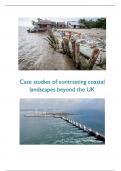Case studies of contrasting coastal
landscapes beyond the UK
,Specification
Case study of a contrasting coastal landscape beyond the UK to illustrate and analyse how it presents
risks and opportunities for human occupation and development and evaluate human responses of
resilience, mitigation and adaptation.
The specification asks us to focus on two key areas in this case study:
1. The risks and opportunities for humans in this coastal environment; and
2. The way that humans have responded to the risks in terms of mitigating the risks,
adapting to them, and building resilience from them. We also need to assess how
successful (or otherwise) those
You only need to have one such case study, but this booklet will cover two contrasting
ones, which you can either select from, or learn both!
Specification Themes and Theory
OPPORTUNITIES AND RISKS
Let us first consider the risks and opportunities which might, in general, exist for coastal areas.
Opportunities Risks
Most of the opportunities are for various a) Economic Isolation: Being located
forms of economic development, all of which at the end of transport links, with
bring income, employment and subsequent catchment areas and populations
economic multipliers in various forms. inevitably limited by the area covered
1. Amenity Value: the coast offers by the sea, means that coastal areas
numerous opportunities for lacking a particular reason for people
recreation, often aided by the to visit can become very isolated and
aesthetic value of the coastal sometimes deprived.
landscape, including walking, b) Erosion: High rates of erosion can
swimming, watersports, sunbathing threaten land, infrastructure and
etc. homes, some of which may have
2. Increased land and housing been built well inland if the rate of
values: residential, retail and office erosion is fast. Although a natural
buildings with sea views can often process, it can be exacerbated by
command higher prices. sediment starvation, often caused by
3. Tourism: The amenity values human intervention in coastal or
mentioned above can draw large fluvial systems.
numbers of both domestic and c) Sea-level rise: The c.20cms sea-
tourists which can boost associated level rise experienced in the last 150
sectors of hospitality, years (and the similar amount
accommodation etc. expected by the end of the 21st
4. Trade: A majority of international century) has caused a worsening of
trade (and some passenger travel) the risks of storm surges and
PAGE 1
, still takes place by boat, and as such farmland salinization (covered below)
major ports need to be located on and has generally increased the risk
the coast, offering associated of flooding with the associated risks
economic opportunities that come to life, livelihoods and property. This
with this infrastructure and the can be exacerbated by isostatic
number of visitors. subsidence, which increases the rate
5. Energy production: The coast is of relative sea level rise in some
often uniquely well-positioned for the areas.
development of energy d) Storm surges (and tsunamis),
infrastructure. Most of Britain’s particularly when occurring in
nuclear power stations are located conjunction with high and spring
on the coast, there are opportunities tides, can cause coastal defenses to
for tidal power, and offshore wind fail, and significant and sometimes
has developed hugely in the 21st unexpected flooding to occur. A
century. large tsumani can cause an even
6. Finally, modern engineering has more extreme version of this, with
presented the opportunity to tame very sizeable risks to infrastructure,
almost any coastal system, if enough life and property.
money is devoted to building and e) Salinisation can occur when
maintaining the necessary significant groundwater abstraction is
infrastructure. However, the size of combined with rising sea levels,
this expenditure can be very high resulting in saline sea water being
indeed. drawn into previously fresh aquifers,
rendering them useless of agriculture,
and lowering local food production
as a result.
f) A secondary risk is that management
(and its associated monitoring and
maintenance) undertaken in order to
mitigate the risks above can cause an
ongoing financial burden on local
and national authorities who oversee
a coastline.
RESILIANCE, MITIGATION AND ADAPTATION
These three broad categories all refer in somewhat different ways to the ways that coastal
communities can respond to the risks that presented by coastal areas. Although they each
have a different emphasis, it should be emphasized that they are not easy to delimit from
one another, are used differently and inconsistently in the literature, and are perhaps best
thought of in terms of three overlapping circles on a venn diagram, as shown below. This
then presents challenges for how you might structure an essay, but also evaluative
opportunities if you are being asked to consider differences between these categories.
PAGE 2




